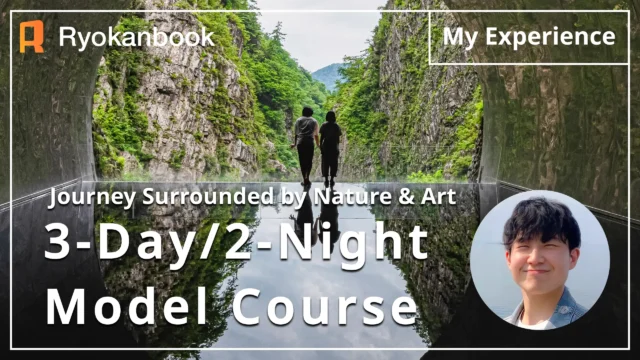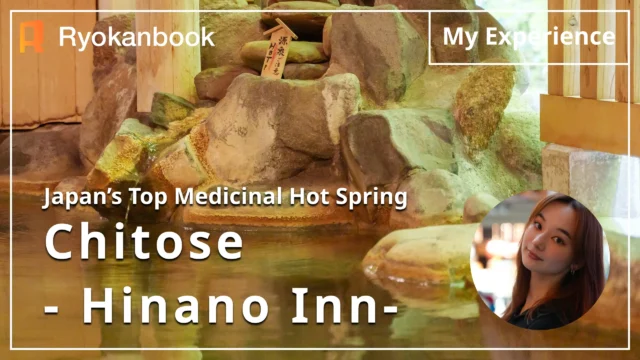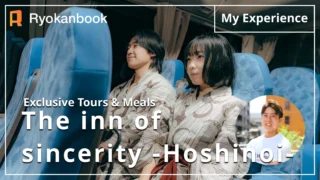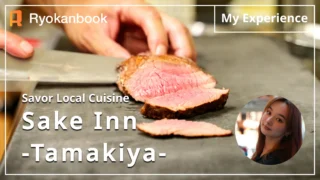This time, I’d like to introduce a stay at a traditional inn in Tokamachi, Niigata—the 150-year-old kominka “Yukino-ya Furusawa-tei,” which I visited in late July, right in the height of summer. Revived through the passion of its host, Mr. Ibi, and his ties with the local community, this house offers a chance to experience what it truly means to “travel as if living there.”
My stay began with an early-morning trek to match the summer heat, followed by a quiet evening at the inn, and continued into the next day with a morning walk and breakfast. In this article, I’ll share that flow of a day just as I experienced it.
▷View more details about “Yukino-ya”

Larisa Kawakami
Hello! I’m a university student currently living in Taiwan. As I travel around Japan, I look forward to encountering not only the people and the land, but also the everyday ways of life that have taken root in each place.
- 1. A Trekking Adventure That Begins with a Word in the Early Morning
- 2. Trekking|Walking through the Satoyama with Scents, Sounds, and Touch
- 3. Evening at the Inn|From “Staying” to “Living”
- 4. Morning Walk|A Deep Breath at Matsuo Shrine
- 5. Breakfast|Flavors Crafted by Hands in the Kitchen
- 6. Ending Thoughts|I’d Love to Visit Again in Another Season
1. A Trekking Adventure That Begins with a Word in the Early Morning
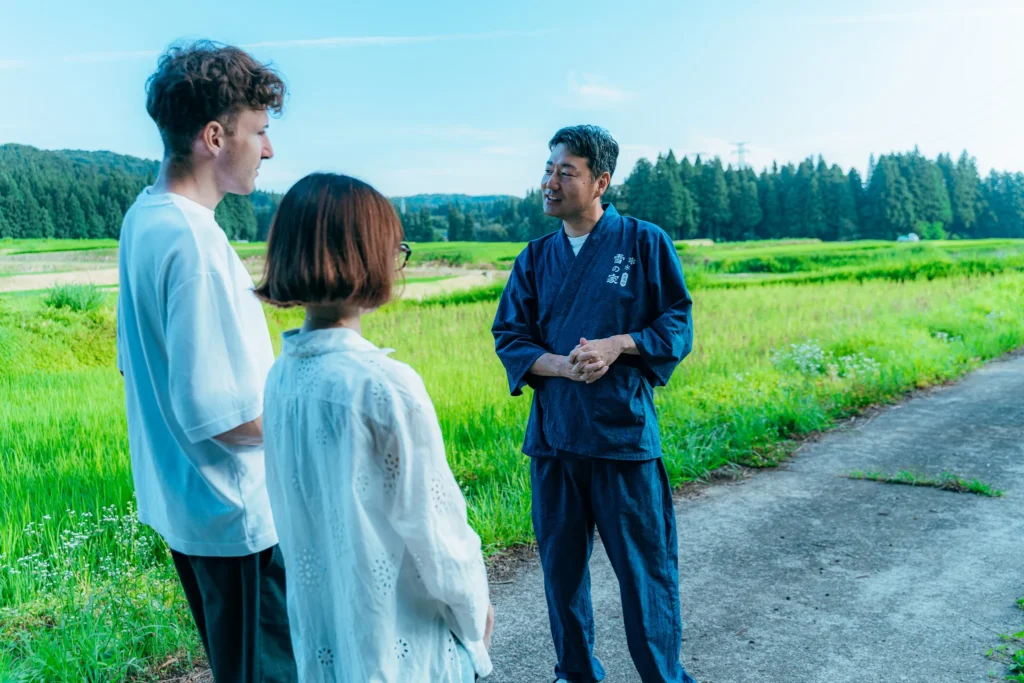
“It’s going to be hot today, so let’s head out before seven.”
That single phrase woke me up.
It was midsummer in Tokamachi, Niigata. Before settling into the old kominka inn, Yukino-ya, we set out on foot to get a feel for the land.
“Let’s go at a comfortable pace.”
Hearing those words eased my shoulders a little. With our host and guide, Mr. Ibi, leading the way, the trekking began.
2. Trekking|Walking through the Satoyama with Scents, Sounds, and Touch
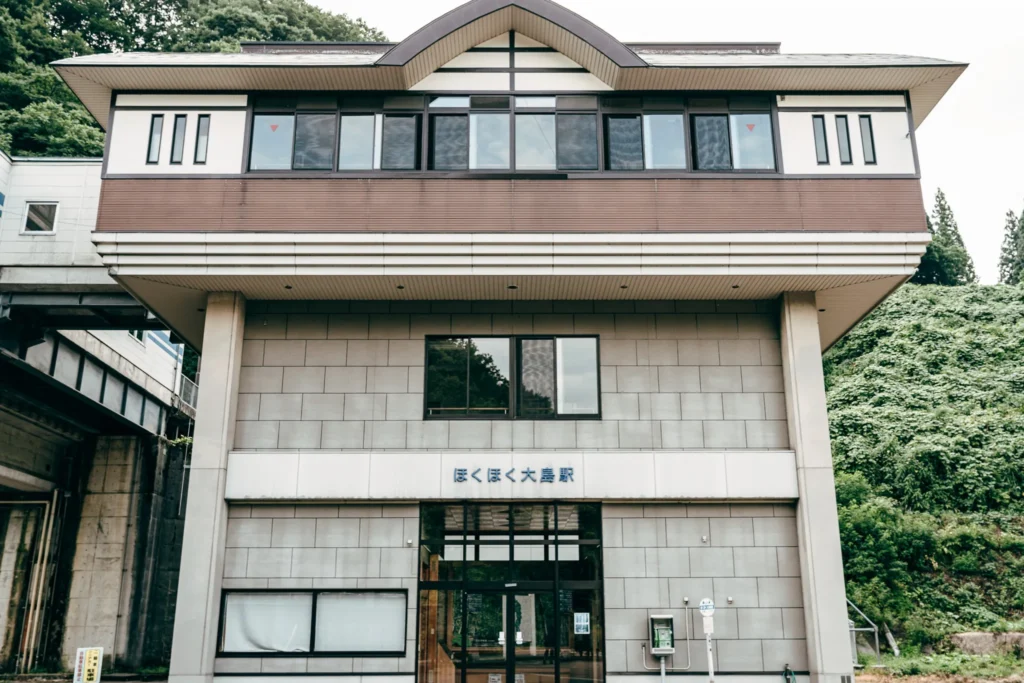
We started from Hokuhoku Oshima Station on the Hokuetsu Express. In the peak of summer heat, the key is to head out early.

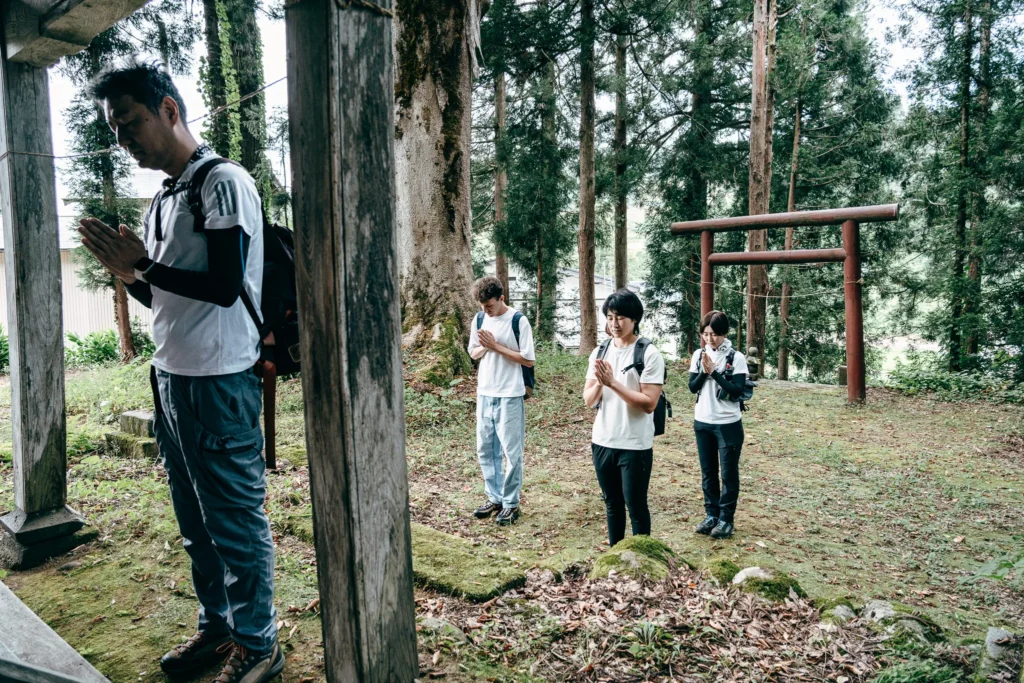
At the first small shrine, we pressed our hands together to pray for safety before entering the mountain. Along the path stood wooden posts once used for hazakake—the traditional way of hanging rice to dry. Traces of everyday life remain quietly etched into the landscape.
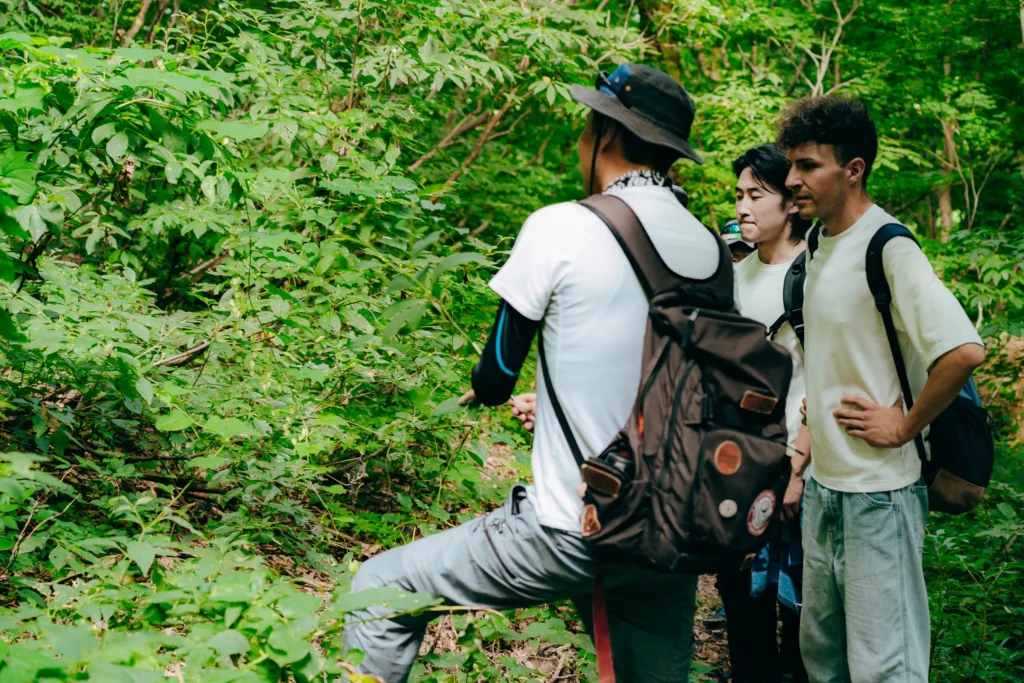
Stepping onto the old unpaved road, I felt the spring of soil under my feet. Rubbing a branch of kuromoji beneath the dappled sunlight released a refreshing scent onto my fingertips.
As we entered the beech forest, the air turned cool. Listening to stories about how the leaves and soil hold water, my pace naturally began to slow.
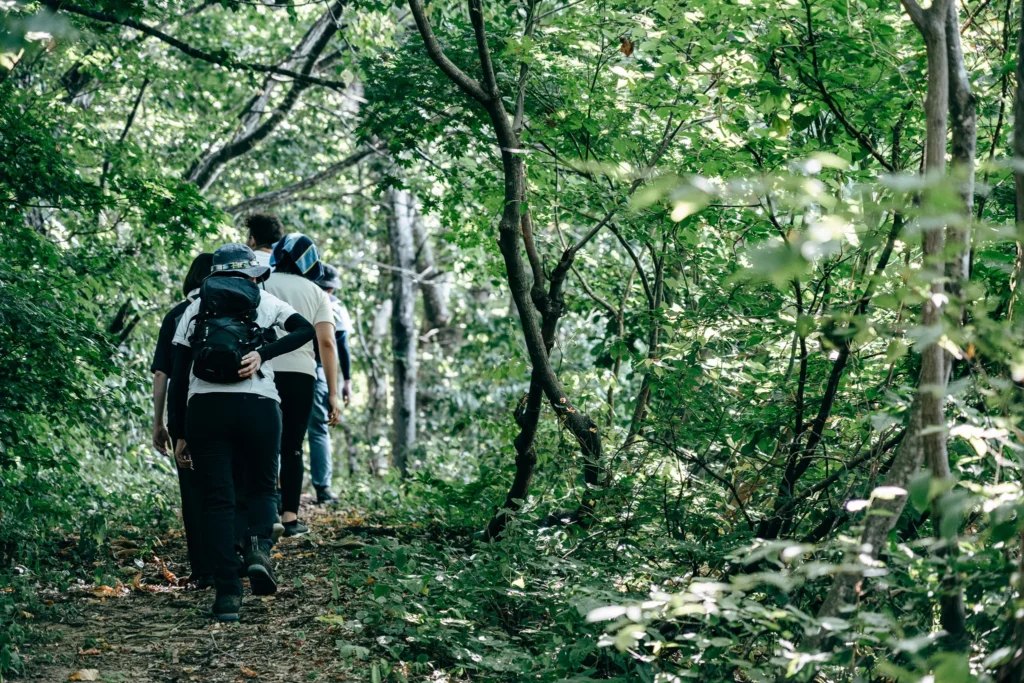
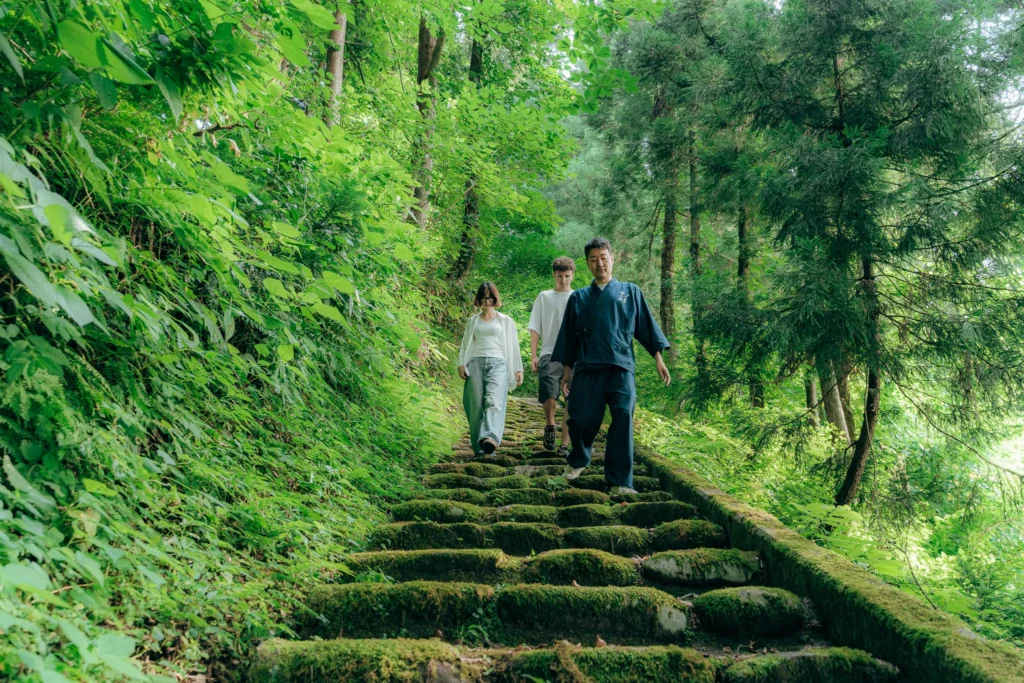
A Story That Stayed with Me
What struck me was the fact that, although this area isn’t at a particularly high elevation, a primeval beech forest spreads out here. The reason, I was told, is the heavy snowfall—causing the beeches to “mistake it for highlands” and take root.
When their leaves fall, they turn into humus-rich forest soil, that soaks up rain like a sponge and slowly releases it back into the ground. That process nurtures groundwater, which in turn supports farming and the ecosystem. Hearing that these trees quietly store water and sustain life without anyone noticing truly left me in awe.

When we reached the summit, the view opened up and the trees rustled all at once with the wind. I could feel the breeze and the fresh air flowing straight into my tired body.
Time for a break. From Mr. Ibi’s backpack came a kettle set and some sasadango (bamboo-leaf rice cakes). Right there, he boiled water and brewed kuromoji tea.
“Here, have some kuromoji herbal tea,” he offered.

So that’s why he picked those branches earlier. The refreshing taste cooled me down and eased away the sweat.
Since I love aromatherapy and herbal teas, I was delighted by this kind of “real” experience—something I’d never had the chance to try back home in Taiwan.
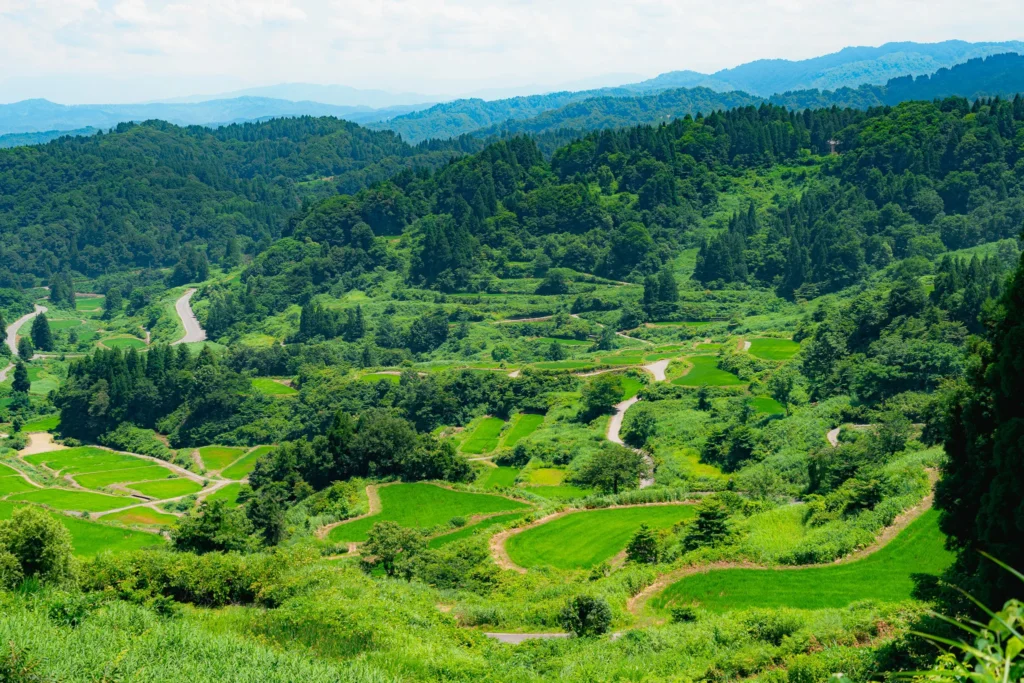
The heat that day was relentless, so we turned back halfway and drove to the scenic terraced rice fields of Hoshitōge. Honestly, I had already reached my physical limit, so I was relieved.
From Hokuhoku Oshima Station, it’s about a three-and-a-half-hour walk to Hoshitōge Tanada. If you’re confident in your stamina, give it a try.
When we arrived at Hoshitōge, we first stopped to offer a prayer at the small Jizō statue—thankful for our safe journey and for the blessings of nature.

What I Learned from Mr. Ibi
“These terraced rice fields can only be preserved because people continue to care for them,” he told me. “But with the aging population, it’s becoming harder to keep them going.”
During the mizukagami season, when the water-filled paddies reflect the sky, visitors increase dramatically. Yet the work of maintaining both the landscape and the fields themselves falls on the shoulders of local residents. Behind the “free-to-see scenery” lies the community’s effort and struggle. Part of the tour fee is donated back to the village, which I thought was a meaningful way to make the experience more than just sightseeing.
Reflections
I heard many things that ordinary tourism would never reveal. Even when I visit other places now, I find myself imagining the stories behind the scenery.
Personally, since I don’t do well with heat, I would recommend coming outside of summer. But if you enjoy hiking, you’ll likely find summer rewarding too. In the end, what struck me most wasn’t the view itself but Mr. Ibi’s words. There’s a weight in the “real thing” that photos or videos can’t capture.
Packing Notes (Summer Satoyama)
- Insect repellent / sunscreen / light long sleeves and pants
- Hiking shoes / rain gear / towel / at least 500ml of water
- Salt tablets or candies
※ From July to September, expect early morning starts.
Spot Details
Name: Hokuhoku Ōshima Station
Address: Shimo-tatsu, Ōshima-ku, Jōetsu City, Niigata Prefecture
https://maps.app.goo.gl/SudvCDNywFE5qF1v6
Access: About 20 minutes from Tokamachi Station via the Hokuhoku Line
▷Learn more about the Hoshitoge Rice Terraces
3. Evening at the Inn|From “Staying” to “Living”

Yukino-ya welcomes only one group per day. Upon arrival, we gathered in the dining room, where traces of a traditional irori (hearth) remain, and listened carefully to the history of the house and tips for making the most of our stay.
For me, it was my first time staying in a traditional house in the snow country.


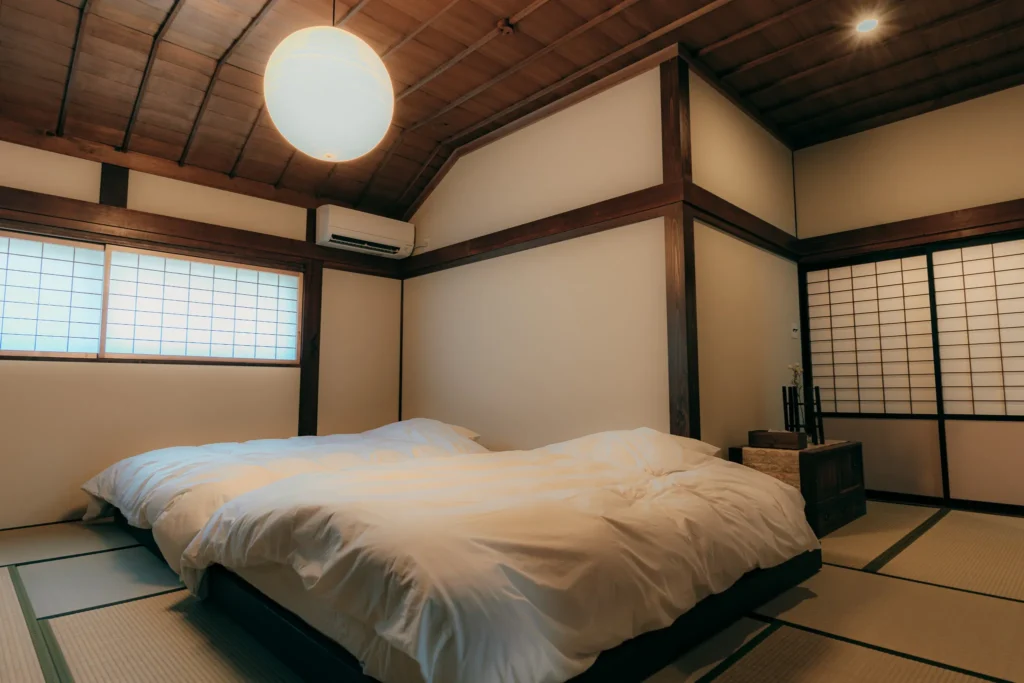
The check-in included about 30 minutes of explanation, which honestly surprised me. The host guided us through the house almost like a museum tour—covering the building’s structure, its history, and even how to use the traditional tools.
It wasn’t just about staying there; I felt I was meant to take something away from this experience. I also noticed clever adaptations unique to life in the snow country.
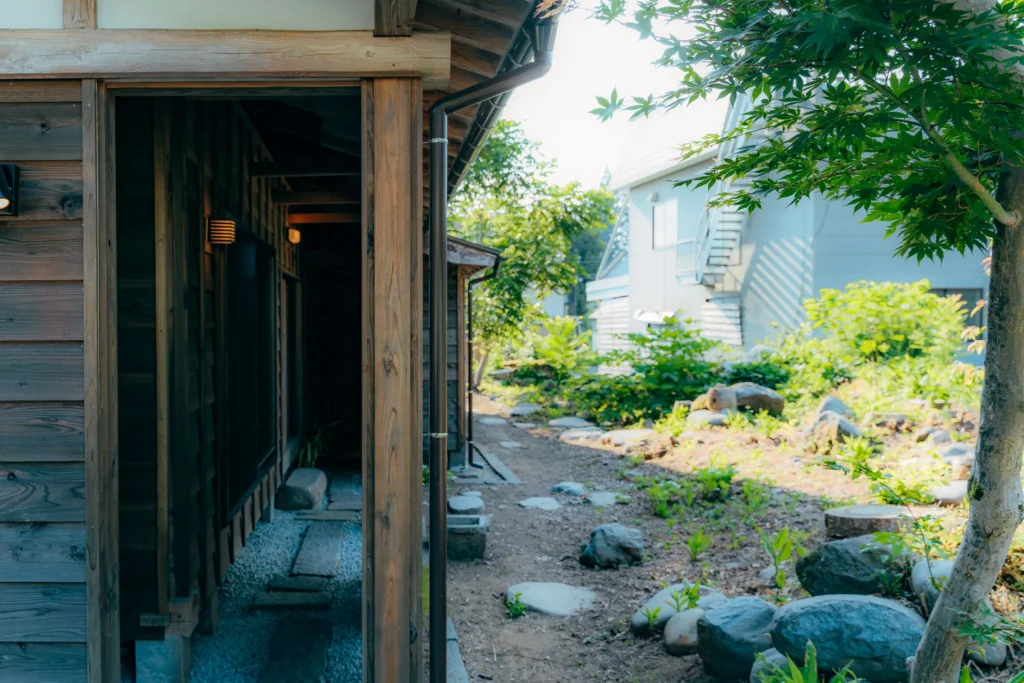
Take, for example,the gangi. Gangi is a covered walkway found in snowy regions like Tokamachi. It turns what would normally be a veranda into a passageway, letting people move around safely even under meters of snow.
In Tokamachi, where snow can exceed three meters, the area that would normally be a veranda is transformed into a covered walkway. It’s a living example of the ingenuity developed to cope with heavy snowfall.

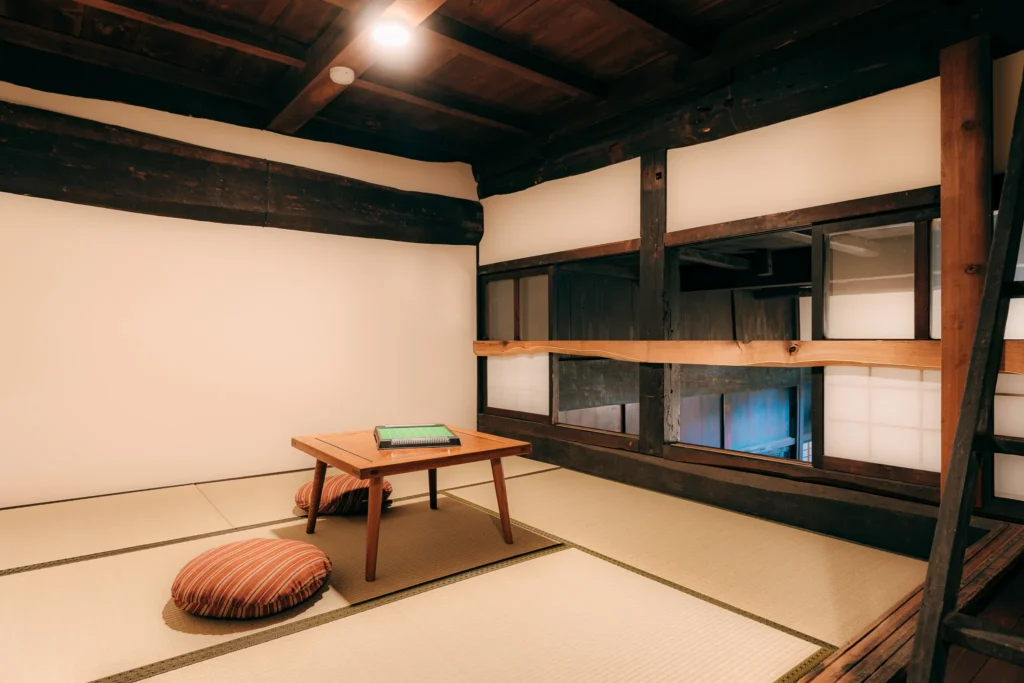
Even in the small loft above the living room, I heard an unforgettable story.
“Originally, there were no stairs here—only a removable ladder. It’s said to have been a measure against yobai.”
Yobai? My mind immediately filled with question marks. Yobai literally means “night crawling” and refers to a traditional practice in some rural areas of Japan where young men would visit women’s homes at night, often secretly, as part of courtship.It was fascinating to get a glimpse into Japanese culture this way. I think hearing stories like this from Mr. Ibi is one of the greatest values of staying at this inn.
Throughout the house, there are many tools and items that people used in the past. I’ll leave those as a surprise for visitors—searching for them is part of the fun, so I won’t go into detail here.

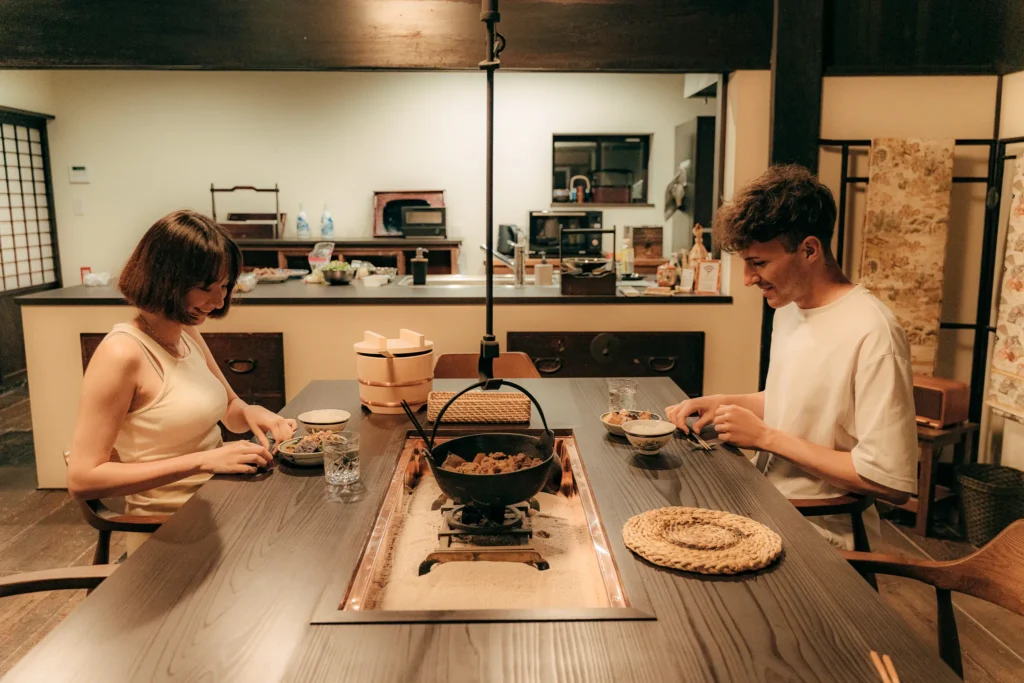
In the evening, we used the irori, a traditional sunken hearth, to cook sukiyaki with ingredients we had bought at a local supermarket. It was my first time using an irori, and I was excited.
We cooked Niigata rice in a donabe (earthenware pot) and then transferred it to an ohitsu (wooden rice container). I learned for the first time why this is done. Simply put, moving the rice stops the residual heat in the pot from over-steaming it, the wood absorbs excess moisture to prevent sogginess, and the wooden surface helps maintain just the right humidity so the rice stays tasty even after it cools. The grains remain firm and delicious, perfect even for making onigiri (rice ball).
Transferring rice to an ohitsu is a uniquely Japanese method, used not only in traditional inns but also in households and sushi restaurants. It keeps the rice at an ideal texture and flavor far better than just “keeping it warm.”
The fragrance of rice cooked in a donabe, the steam rising from the ohitsu, the texture of the dishes in hand—it all felt so alive. Despite the house’s historical charm, the water areas are clean and well-maintained, making the stay comfortable and safe for women as well.
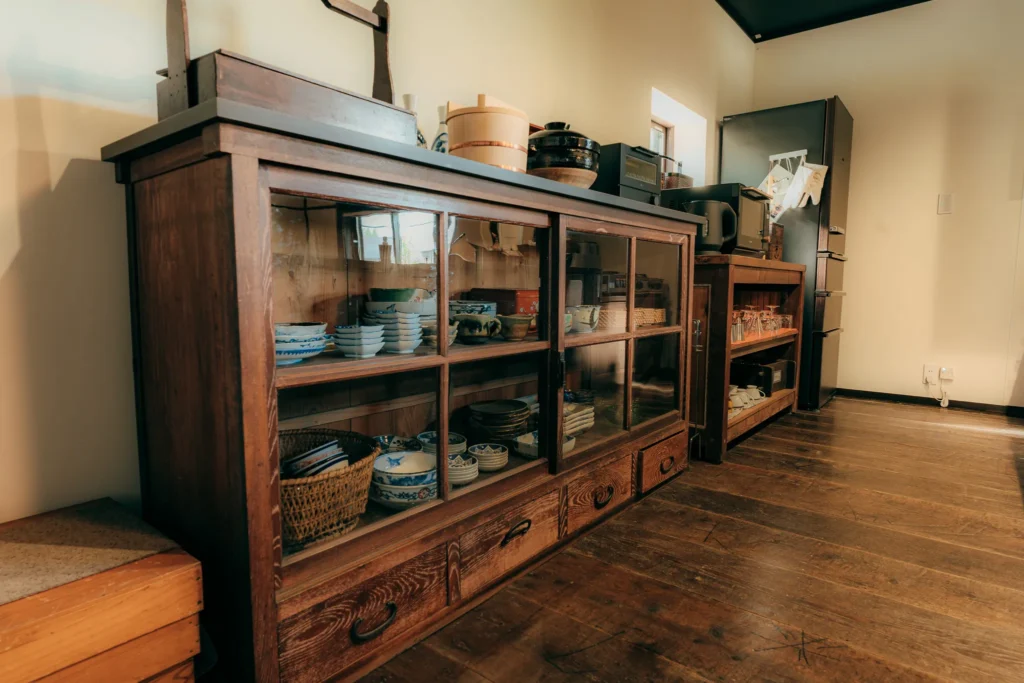
“They didn’t buy any new dishes—everything here has been passed down from this house and the local community.”
Hearing that, the tiny chips and scratches on the bowls suddenly felt endearing.

I soaked in the bathtub, washing away the fatigue from the trekking. The bathroom and toilet were clean and well-maintained, making the stay comfortable.

The last surprise awaited at the entrance—it was very small, requiring everyone to bow their head to enter. When we were leaving, Mr. Ibi opened it fully to show us.
“This tiny entrance carries the meaning: ‘Bow your head when you enter.’ Actually, it can open completely.”
Until the very end, this house kept astonishing me.
4. Morning Walk|A Deep Breath at Matsuo Shrine
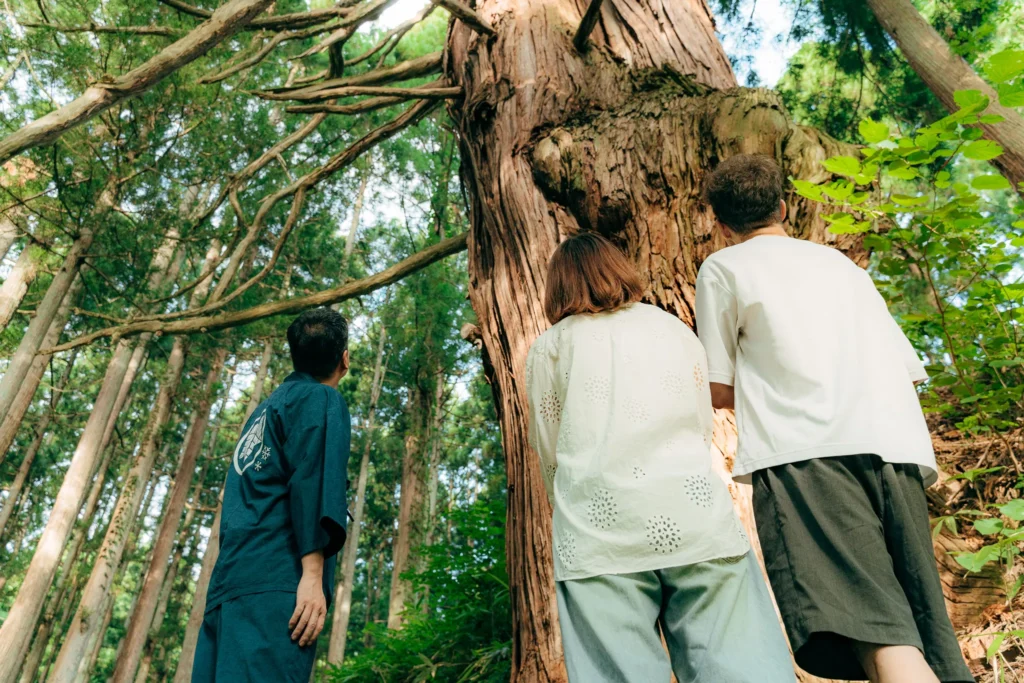
The next morning, we walked just a minute from the inn to Matsuo Shrine. Honestly, getting up early was tough, but as we entered the cedar forest, the cool air and the scent of the trees immediately woke me up.
Along the stone-paved steps stood the Meoto-sugi, or “Married Cedars”—two cedar trees said to be over 500 years old, growing side by side. Looking up, I had to crane my neck to take in their sheer size.
After passing the shrine, the view opened up to rice fields, with the sound of the wind and birdsong all around. At our feet, plants like myōga (a type of Japanese ginger) and sanshō (Japanese pepper) grew naturally—ingredients used in local cooking—and tiny frogs hopped about.
The morning air, so fresh and alive, filled my body in a way I could only experience by coming here.
5. Breakfast|Flavors Crafted by Hands in the Kitchen
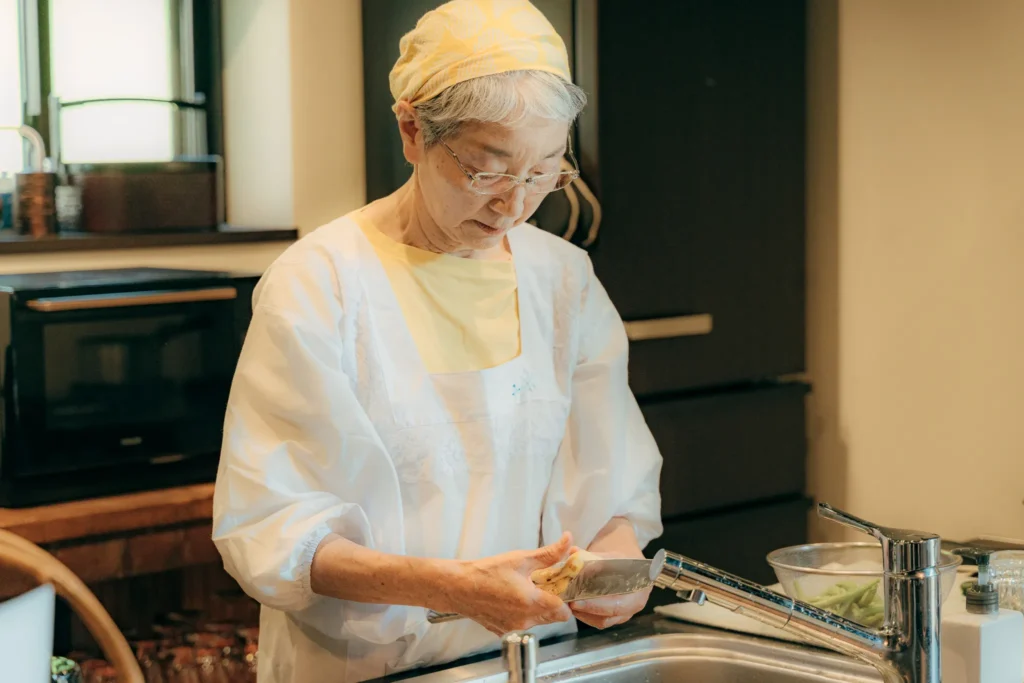
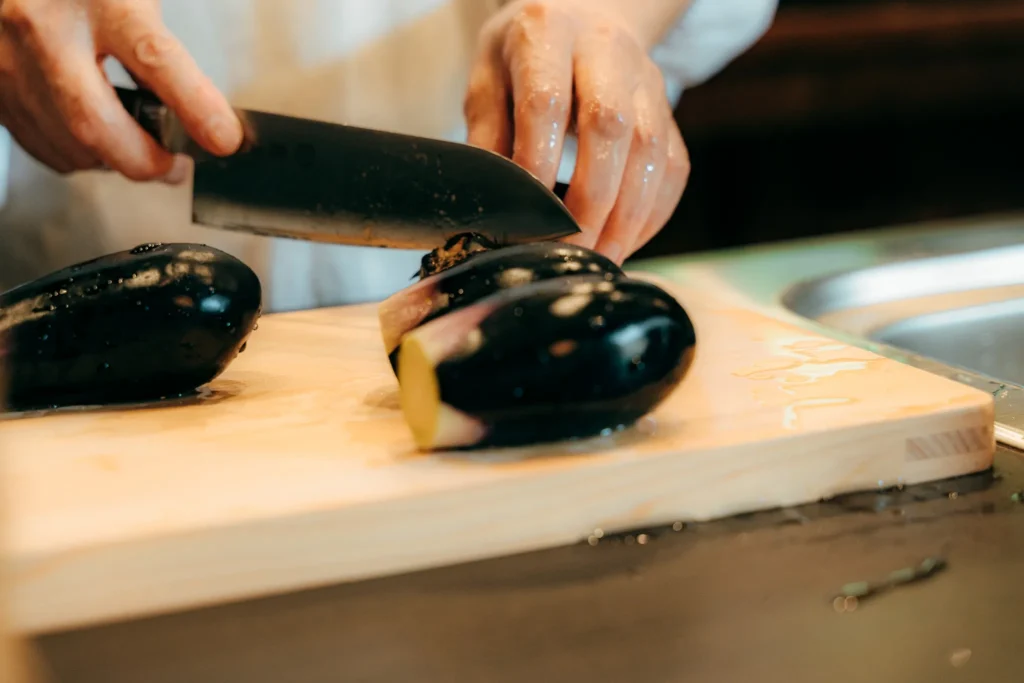

After the walk, a local woman stood in the kitchen to prepare breakfast. We picked shiso (Japanese perilla) from the backyard and helped out together.
This is another example of the charm of having only one group per day—the hosts do so much just for us, and it really made me feel the connection between people and the place.
Impression of the Host Mother
She doesn’t live at the inn full-time, yet she comes all the way to cook for us. Truly, she felt like a “Japanese mother.” I felt both a sense of wonder—why would she go to such lengths?—and warmth at the same time.

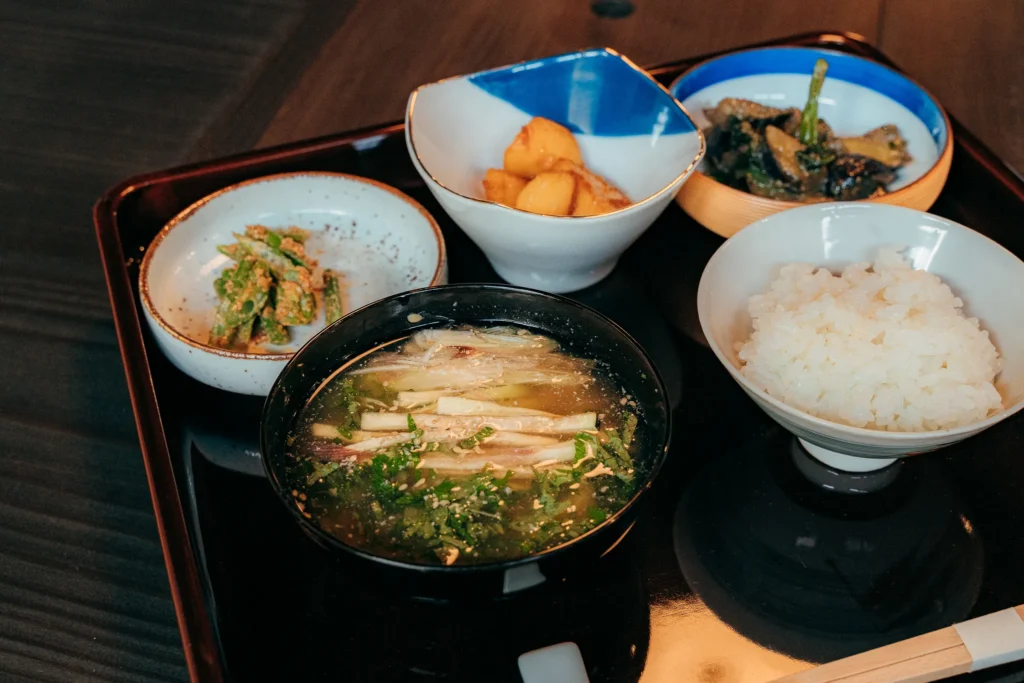
and added it to the hiyajiru (a cold miso soup), the aroma rising from the bowl somehow connected back to the forest we had just walked through.
It was my first time trying hiyajiru, but my body reacted immediately—delicious! I honestly thought, next time, I want to bring my friends from Taiwan here.
6. Ending Thoughts|I’d Love to Visit Again in Another Season

Mr. Ibi’s wish to “preserve the pure parts of this region” came through in every aspect of our stay. I think that’s the true charm of staying in a traditional kominka—a historic Japanese house, often over a hundred years old, with wooden architecture and traditional features.
Quiet mornings, the glow of the fire, the scent of the fields, the fragrance of the cedar forest—though my stay was short, I truly felt like I was living there. The summer waves of rice and the white stillness of winter must show completely different faces of the same place. I’ll definitely come back, in another season.
Spot: Yukino-ya Furusawa-tei
Address: 170 An’yōji, Tōkamachi, Niigata 949-8562, Japan
Google Maps Link
Access: Joetsu Shinkansen to Echigo-Yuzawa Station → Hokuhoku Line to Tōkamachi Station → Approximately 15 minutes by car.
- Taxi arrangement is possible from Echigo-Yuzawa Station for an additional fee (approximately 40 minutes by car).
- Complimentary shuttle service is available from Tōkamachi Station.
Parking: Free dedicated parking available.
Book your stay at “Yukino-ya Furusawa-tei” here:https://www.ryokan-book.com/en/area/tokamachi/ryokan/yukinoya/
▷Discover more about Tokamachi
Written by Larisa, translated by Yuka



